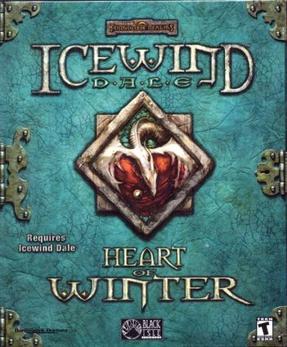
Neverwinter Nights is a third-person role-playing video game developed by BioWare. Interplay Entertainment was originally set to publish the game, but financial difficulties led to it being taken over by Infogrames, who released the game under their Atari range of titles. It is the first installment in the Neverwinter Nights series and was released for Microsoft Windows on June 18, 2002. BioWare later released a Linux client in June 2003, requiring a purchased copy of the game to play. MacSoft released a Mac OS X port in August 2003.
The Ur-Quan Masters is a 2002 open-source fangame modification, based on the action-adventure science fiction game Star Control II. The original game was released for PCs in 1992 and ported to the 3DO Interactive Multiplayer in 1994. It has been frequently mentioned among the best games of all time, with additional praise for its writing, world design, character design, and music.

The Elder Scrolls III: Morrowind is an open-world action role-playing video game developed by Bethesda Game Studios and published by Bethesda Softworks. It is the third installment in The Elder Scrolls series, following 1996's The Elder Scrolls II: Daggerfall, and was released in 2002 for Microsoft Windows and Xbox. The main story takes place on Vvardenfell, an island in the Dunmer province of Morrowind, part of the continent of Tamriel. The central quests concern the demigod Dagoth Ur, housed within the volcanic Red Mountain, who seeks to gain power and break Morrowind free from Imperial reign.

Baldur's Gate II: Shadows of Amn is a role-playing video game developed by BioWare and published by Interplay Entertainment. It is the sequel to Baldur's Gate (1998) and was released for Microsoft Windows in September 2000. Like Baldur's Gate, the game takes place in the Forgotten Realms—a fantasy campaign setting—and is based on the Advanced Dungeons & Dragons 2nd edition rules. Powered by BioWare's Infinity Engine, Baldur's Gate II uses an isometric perspective and pausable real-time gameplay. The player controls a party of up to six characters, one of whom is the player-created protagonist, while the others are certain characters recruited from the game world.
Tactical role-playing games, also known as strategy role-playing games and in Japan as simulation RPGs, are a video game genre that combines core elements of role-playing video games with those of tactical strategy video games. The formats of tactical RPGs are much like traditional tabletop role-playing games and strategy games in appearance, pacing, and rule structure. Likewise, early tabletop role-playing games are descended from skirmish wargames such as Chainmail, which were primarily concerned with combat.

Icewind Dale: Heart of Winter is a 2001 expansion pack to the role-playing video game Icewind Dale, developed by Black Isle Studios and published by Interplay Entertainment. It introduced many changes and additions to the original game, and included a new campaign. A downloadable add-on to this expansion pack, titled Trials of the Luremaster, was released for free. Both the expansion and add-on were included in Icewind Dale: Enhanced Edition.

Arx Fatalis is a 2002 action role-playing game developed by Arkane Studios and released for Windows and Xbox. The game is played from a first-person perspective and is set on a world whose sun has failed, forcing the above-ground creatures to take refuge in caverns. The game's mechanics include the use of mouse gestures to cast spells. Arx Fatalis received mostly positive reviews from critics but was not commercially successful. In 2011, Arkane Studios released the game's source code under the GNU General Public License (GPL), though the game assets remain proprietary.

Wizardry 8 is the last installment in the Wizardry series of role-playing video games developed by Sir-Tech Canada. Serving as the third game in the "Dark Savant trilogy," it follows Wizardry VI: Bane of the Cosmic Forge and Wizardry VII: Crusaders of the Dark Savant. Originally published in 2001 by Sir-Tech, it was later re-released by Night Dive Studios on GOG.com and Steam in 2013.

Beyond Divinity is an action role-playing game by Larian Studios released in 2004. It is a sequel to Divine Divinity.

Baldur's Gate is a role-playing video game that was developed by BioWare and published in 1998 by Interplay Entertainment. It is the first game in the Baldur's Gate series and takes place in the Forgotten Realms, a high fantasy campaign setting, using a modified version of the Advanced Dungeons & Dragons (AD&D) 2nd edition rules. It was the first game to use the Infinity Engine for its graphics, with Interplay using the engine for other Forgotten Realms-licensed games, including the Icewind Dale series and Planescape: Torment. The game's story focuses on a player-made character who travels across the Sword Coast alongside a party of companions.

Fallout: A Post Nuclear Role Playing Game is a 1997 role-playing video game developed and published by Interplay Productions. In a mid-22nd century post-apocalyptic and retro-futuristic world, decades after a global nuclear war between the United States and China, Fallout's protagonist, the Vault Dweller, inhabits the underground nuclear shelter Vault 13. After customizing their character, the player must scour the surrounding wasteland for a computer chip that can fix the Vault's failed water supply system. They interact with other survivors, some of whom give them missions, and engage in turn-based combat where they battle until their action points are depleted.

Star Trek: Starfleet Command III is a Star Trek video game published in 2002. It was the fourth entry in the Starfleet Command series, and one of the last Star Trek games to be released by Activision. The game involves the a story-driven series of missions for three factions, that is conducted by controlling starships that are developed with RPG elements. The game was released for Windows operating system, and received generally positive reviews.

Larian Studios is a Belgian independent video game developer and publisher founded in 1996 by Swen Vincke. Headquartered in Ghent, Belgium, Larian focuses on developing role-playing video games but has previously worked on educational games and casino games. It is best known for developing the Divinity series and Baldur's Gate 3.

Divinity II is an action role-playing game developed by Larian Studios. Its first release in 2009 was subtitled Ego Draconis and was published by dtp entertainment and in the United States by cdv Software Entertainment. The updated 2010 re-release The Dragon Knight Saga which included the expansion Flames of Vengeance, as well as the final 2012 release as Divinity II: Developer's Cut, were published by Focus Home Interactive.

Divinity: Original Sin is a role-playing video game developed and published by Larian Studios. The fourth main entry in the Divinity game series, it is a prequel to the original game Divine Divinity, and to the other main games in the series. It was first released on Microsoft Windows on 30 June 2014.

Divinity: Dragon Commander is a real-time strategy video game developed by Larian Studios as part of the Divinity series of fantasy role-playing games. The game features a hybrid of gameplay styles and has single-player, competitive multiplayer and cooperative multiplayer modes.

Swen Johan Vincke is a Belgian video game designer, programmer and director. He is the founder and CEO of the video game company Larian Studios, where he has led the development of the Divinity series and Baldur's Gate 3.

Divinity: Original Sin II is a role-playing video game developed and published by Larian Studios. The sequel to 2014's Divinity: Original Sin and the fifth main entry in the Divinity series, the game was released for Microsoft Windows in September 2017. The player controls a "Godwoken", a Sourcerer who can harness and use a powerful magic known as Source, and becomes a pivotal figure in the fight against the Voidwoken, monstrous creatures who wreak havoc in the medieval fantasy world of Rivellon.

Baldur's Gate 3 is a 2023 role-playing video game developed and published by Belgian game developer Larian Studios. The game is the third main installment in the Baldur's Gate series, based on the tabletop fantasy role-playing system of Dungeons & Dragons. A partial version of the game was released in early access format for macOS and Windows in October 2020. It remained in early access until its full release for Windows in August 2023, with versions for PlayStation 5, macOS, and Xbox Series X/S releasing later that year.
Divinity is a role-playing video game series developed by Larian Studios. The franchise was introduced in 2002 with Divine Divinity. The franchise received more mainstream attention following the critically and commercially successful release of Divinity: Original Sin (2014).

















